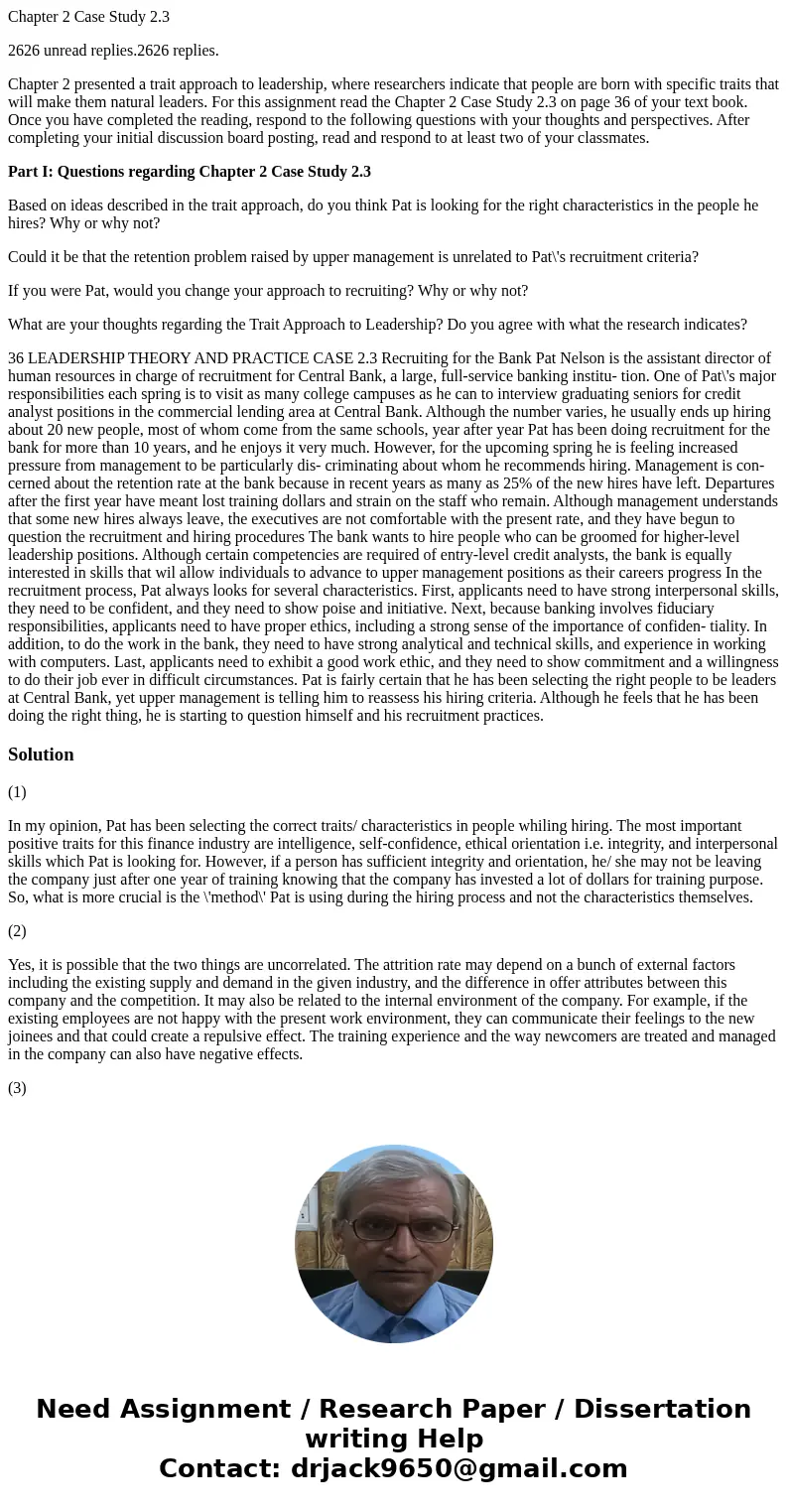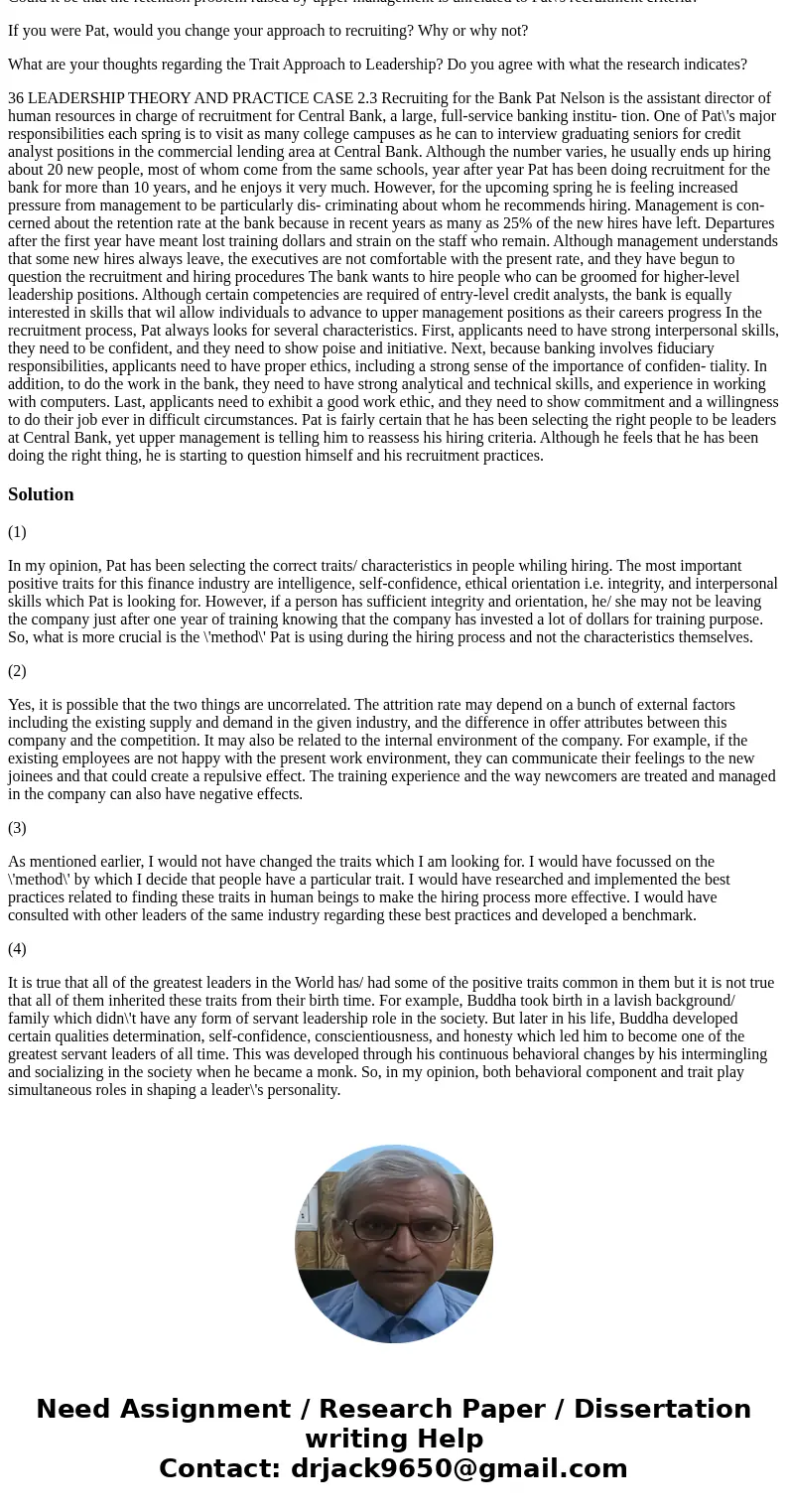Chapter 2 Case Study 23 2626 unread replies2626 replies Chap
Chapter 2 Case Study 2.3
2626 unread replies.2626 replies.
Chapter 2 presented a trait approach to leadership, where researchers indicate that people are born with specific traits that will make them natural leaders. For this assignment read the Chapter 2 Case Study 2.3 on page 36 of your text book. Once you have completed the reading, respond to the following questions with your thoughts and perspectives. After completing your initial discussion board posting, read and respond to at least two of your classmates.
Part I: Questions regarding Chapter 2 Case Study 2.3
Based on ideas described in the trait approach, do you think Pat is looking for the right characteristics in the people he hires? Why or why not?
Could it be that the retention problem raised by upper management is unrelated to Pat\'s recruitment criteria?
If you were Pat, would you change your approach to recruiting? Why or why not?
What are your thoughts regarding the Trait Approach to Leadership? Do you agree with what the research indicates?
36 LEADERSHIP THEORY AND PRACTICE CASE 2.3 Recruiting for the Bank Pat Nelson is the assistant director of human resources in charge of recruitment for Central Bank, a large, full-service banking institu- tion. One of Pat\'s major responsibilities each spring is to visit as many college campuses as he can to interview graduating seniors for credit analyst positions in the commercial lending area at Central Bank. Although the number varies, he usually ends up hiring about 20 new people, most of whom come from the same schools, year after year Pat has been doing recruitment for the bank for more than 10 years, and he enjoys it very much. However, for the upcoming spring he is feeling increased pressure from management to be particularly dis- criminating about whom he recommends hiring. Management is con- cerned about the retention rate at the bank because in recent years as many as 25% of the new hires have left. Departures after the first year have meant lost training dollars and strain on the staff who remain. Although management understands that some new hires always leave, the executives are not comfortable with the present rate, and they have begun to question the recruitment and hiring procedures The bank wants to hire people who can be groomed for higher-level leadership positions. Although certain competencies are required of entry-level credit analysts, the bank is equally interested in skills that wil allow individuals to advance to upper management positions as their careers progress In the recruitment process, Pat always looks for several characteristics. First, applicants need to have strong interpersonal skills, they need to be confident, and they need to show poise and initiative. Next, because banking involves fiduciary responsibilities, applicants need to have proper ethics, including a strong sense of the importance of confiden- tiality. In addition, to do the work in the bank, they need to have strong analytical and technical skills, and experience in working with computers. Last, applicants need to exhibit a good work ethic, and they need to show commitment and a willingness to do their job ever in difficult circumstances. Pat is fairly certain that he has been selecting the right people to be leaders at Central Bank, yet upper management is telling him to reassess his hiring criteria. Although he feels that he has been doing the right thing, he is starting to question himself and his recruitment practices.Solution
(1)
In my opinion, Pat has been selecting the correct traits/ characteristics in people whiling hiring. The most important positive traits for this finance industry are intelligence, self-confidence, ethical orientation i.e. integrity, and interpersonal skills which Pat is looking for. However, if a person has sufficient integrity and orientation, he/ she may not be leaving the company just after one year of training knowing that the company has invested a lot of dollars for training purpose. So, what is more crucial is the \'method\' Pat is using during the hiring process and not the characteristics themselves.
(2)
Yes, it is possible that the two things are uncorrelated. The attrition rate may depend on a bunch of external factors including the existing supply and demand in the given industry, and the difference in offer attributes between this company and the competition. It may also be related to the internal environment of the company. For example, if the existing employees are not happy with the present work environment, they can communicate their feelings to the new joinees and that could create a repulsive effect. The training experience and the way newcomers are treated and managed in the company can also have negative effects.
(3)
As mentioned earlier, I would not have changed the traits which I am looking for. I would have focussed on the \'method\' by which I decide that people have a particular trait. I would have researched and implemented the best practices related to finding these traits in human beings to make the hiring process more effective. I would have consulted with other leaders of the same industry regarding these best practices and developed a benchmark.
(4)
It is true that all of the greatest leaders in the World has/ had some of the positive traits common in them but it is not true that all of them inherited these traits from their birth time. For example, Buddha took birth in a lavish background/ family which didn\'t have any form of servant leadership role in the society. But later in his life, Buddha developed certain qualities determination, self-confidence, conscientiousness, and honesty which led him to become one of the greatest servant leaders of all time. This was developed through his continuous behavioral changes by his intermingling and socializing in the society when he became a monk. So, in my opinion, both behavioral component and trait play simultaneous roles in shaping a leader\'s personality.


 Homework Sourse
Homework Sourse